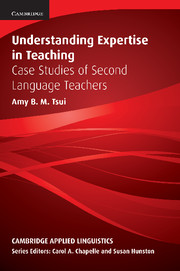Book contents
- Frontmatter
- Contents
- Series Editors' Preface
- Acknowledgments
- Chapter 1 Introduction
- Chapter 2 Conceptions of Expertise
- Chapter 3 Characteristics of Expert and Novice Teachers
- Chapter 4 Teacher Knowledge
- Chapter 5 The Case Studies
- Chapter 6 The Professional Development of the ESL Teachers
- Chapter 7 Teacher Knowledge and Managing the Classroom for ESL Learning
- Chapter 8 Teacher Knowledge and the Enactment of the ESL Curriculum
- Chapter 9 Taking on the Challenge: Exploring Process Writing
- Chapter 10 Understanding Expertise in Teaching
- Appendix 1 Reader's Comment Form on First Draft for the Second Writing Task (Angel's First Draft)
- Appendix 2 Learner Training in Making Revisions
- References
- Index
Chapter 8 - Teacher Knowledge and the Enactment of the ESL Curriculum
Published online by Cambridge University Press: 05 October 2012
- Frontmatter
- Contents
- Series Editors' Preface
- Acknowledgments
- Chapter 1 Introduction
- Chapter 2 Conceptions of Expertise
- Chapter 3 Characteristics of Expert and Novice Teachers
- Chapter 4 Teacher Knowledge
- Chapter 5 The Case Studies
- Chapter 6 The Professional Development of the ESL Teachers
- Chapter 7 Teacher Knowledge and Managing the Classroom for ESL Learning
- Chapter 8 Teacher Knowledge and the Enactment of the ESL Curriculum
- Chapter 9 Taking on the Challenge: Exploring Process Writing
- Chapter 10 Understanding Expertise in Teaching
- Appendix 1 Reader's Comment Form on First Draft for the Second Writing Task (Angel's First Draft)
- Appendix 2 Learner Training in Making Revisions
- References
- Index
Summary
In Chapter 7 we investigated how the four ESL teachers managed their classrooms for learning. We have seen that Marina has built up a rich repertoire of routines to handle the multifaceted nature of classroom teaching. We have also seen that embedded in what appears to be a mundane routine is Marina's situated knowledge about teaching, learning, and her students. Such knowledge, as Elbaz (1983) points out, shapes teachers' world of practice and classroom life. Compared to Marina, the other three teachers have a much less-rich repertoire of routines and norms, with Genie still trying to establish routines and norms that would reconcile her own beliefs and the realities of the classroom.
In this chapter we shall be looking at the knowledge embedded in these four teachers' interpretation and implementation of the ESL curriculum and how their knowledge developed over the years. In the review of novice-expert studies in Chapter 3, we have examined studies conducted on the preactive and interactive decision making of novice and expert teachers. While curriculum or lesson planning and the actual teaching constitute two different phases of teaching, the decisions made in the preactive phase of teaching are often intertwined with the way learning is managed in the lesson. Therefore, in this chapter, I shall simply organize the discussion according to the planning and the enactment of the ESL curriculum.
- Type
- Chapter
- Information
- Understanding Expertise in TeachingCase Studies of Second Language Teachers, pp. 177 - 224Publisher: Cambridge University PressPrint publication year: 2003



